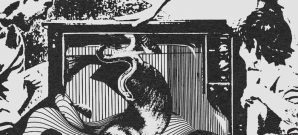 How does one get a handle on Bob Mould? The musician is an alt-punk icon, starting with his seminal eighties punk band, Hüsker Dü (QRO spotlight on), as well as finding serious nineties alt-rock success in fronting Sugar, and having putting out acclaimed solo records from post-Hüsker to today. Few have managed the transition from speedcore agit-punk to acoustic singer/songwriter as well as he has, or have made as good music at either end of the spectrum – as well as in everything in between. Mould is loved by many, and considered both a major influence and artist.
How does one get a handle on Bob Mould? The musician is an alt-punk icon, starting with his seminal eighties punk band, Hüsker Dü (QRO spotlight on), as well as finding serious nineties alt-rock success in fronting Sugar, and having putting out acclaimed solo records from post-Hüsker to today. Few have managed the transition from speedcore agit-punk to acoustic singer/songwriter as well as he has, or have made as good music at either end of the spectrum – as well as in everything in between. Mould is loved by many, and considered both a major influence and artist.
It can also be rather difficult to be a Bob Mould fan. There’s the ugly wreckage of the break-up of Hüsker Dü, including serious bad blood with co-songwriter Grant Hart (QRO interview), his dismissive nature towards bassist Greg Norton, financial disputes with those two and first label SST – not all Mould’s fault, for sure, but not all not his fault, either. There was his long post-Hüsker unwillingness to revisit the great material on which he’d made his name. There was the short life of the popular Sugar (and some bad blood after that group ended as well). There’s the impression of him being rather stand-off-ish, thanks to some poor encounters with the music press (including a SPIN interview that he felt poorly handled his not-in-the-closet, but private, homosexuality). There’s that lack of a geographic hometown to pigeonhole him in – born & raised in Uppermost State New York, his musical birth & Hüsker life in Minneapolis, and stints living in New York (twice), Austin, D.C. (providing the name for 2008’s District Line – QRO review), and now San Francisco. Oh, and there was his poorly-received dive into electronica, after leaving two decades of guitar-driven rock, only to eventually create something a split persona in recent days – returning to his entire discography as the Bob Mould Band (QRO live review), but also doing DJ nights at gay-themed dance parties as one half of Blowoff.
Whatever else one could say about Bob Mould, he has certainly lived a life that warrants an autobiography. See a Little Light: The Trail of Rage and Melody enjoys & suffers many of his said highs and lows, as well as that of any rock ‘n’ roll autobiography, but certainly makes for an interesting read.
Mould’s early years in Malone, New York, are done well if not exceedingly so – particularly fascinating is that, shortly after his birth, his nine-year-old brother Stephen died of nephroblastoma, making the baby Bob the ‘golden boy’ of his dysfunctional family, which brought about a self-confidence bordering on narcissism for Mould (as diagnosed by Mould himself) that lead to everything from him getting on stage to writing an autobiography (no one could write one without a touch of narcissism…). But his descriptions of his drunk, violent, and seemingly homophobic father conflict with Mould’s affection for him then & now (how much good will did his father earn by buying and driving out a van from Malone to Minneapolis, even if he did it twice?…). And Mould’s (living) siblings are virtually not in the book (perhaps because they were well older, and left the house when Mould was still growing up).
Most readers are going to read See a Little Light for the Hüsker Dü portion of the book, and Mould doesn’t skip over his seminal band, one of the pillars of eighties punk. There are tales of the early, DIY days, blistering live shows, as well as the group’s evolution in ways good (in the music) and bad (for the band) – even their appearance on FOX’s short-lived challenge to Johnny Carson’s Tonight Show, The Late Show with Joan Rivers. Encounters with his idols, with no-names who’d go on to notoriety, and with his contemporaries are all included – even Jon Leibowitz, now Stewart (whose Daily Show has a theme song, “Dog On Fire”, written by Mould).
Hüsker Dü performing on Late SHow with Joan Rivers:
The details of the inner workings of Hüsker Dü are engrossing, even if one can never quite shake the feeling that not only this is just one side of the story (how could it not be?), but that Mould is being kind of ‘forced’ to talk about it. He seems conflicted about how to talk about Hart – praising Hart’s ability, but also undercutting his co-songwriter with instances of tension and even derision that become more frequent as this portion of the book goes on, culminating in a meeting with his bandmates at Hart’s parents’ house to address Hart’s heroin use (of which Mould very deliberately hints at, yet claims at the time to have been ignorant about to the point of obtuseness). Mould is at pains to say that Hart’s heroin use wasn’t the only/main cause of the band’s break-up, even citing Mould’s own decision to become sober as a factor, and pointing to all the instances of creative (and occasionally financial) disagreement that would occur in any trio with two songwriters. Of course, this is all probably how Mould actually feels about Hart, even to this day – there is nothing in the book to give hope to the idea of an Hüsker Dü reunion.
Greg Norton, on the other hand, gets a rather shorter shrift, increasingly only mentioned for his neutrality or, especially, his lack of input/work in the band. The bassist has gotten something of a saintly aura in the post-Hüsker years, as no one could blame him for the group’s break-up, and appreciating him was an easy way out not picking a side in the so-called Mould-Hart debate (a debate neither songwriter encouraged). Plus, the handlebar mustache… But if Norton is a saint, he’s the Saint of Not Being There, as Mould makes clear, going so far as to say that, while the group was still together, he had “lost respect” for Norton’s non-contribution to the band (even saying that Norton chose playing a daily round of golf over doing more in the band – the highest praise in the entire book for the bassist is that he did most of the driving). There is even some rather bitter post-break-up commentary on Norton getting his share of the Hüsker ‘estate’ significantly increased above what had been agreed to/what Mould seems to think that Norton deserves. It’s a corrective to the rose-colored affection that fans have for Norton, but it can feel overdone to the point of vindictiveness. In contrast, while label SST gets (deservedly) glowing praise in the beginning of the band’s life, and some ominous notes of warning in the middle, yet almost none of the criticism for mishandling them later on (also deserved), save for the label failing to make enough copies of Zen Arcade.
Of the seminal 1984 double-LP concept album, Mould says, ”
,” an undoubtedly true comment that all fans should be told, and something Mould is both sheepish and explanatory in saying, but still highlights the feeling that Mould knows that he has to write about Hüsker, and does write about Hüsker, but really would rather not, and almost seems to think less of those that are mostly interested in his biography/discography for it (even if they’re the majority of readers).
Of course, people are drawn to drama and tragedy – the interesting times are the hard times, that’s what the ancient Chinese curse was about. Thus, the two-plus decades after Hüsker Dü that form the majority of the book usually can’t match that drama. But they are, in many ways, more interesting. For one, they’ve been less detailed – for instance, the short-but-bright life of Sugar, his 1992-95 trio that enjoyed commercial success in the alt-rock boom of the early-to-mid-nineties, is a story that hasn’t been told, and it’s a nice one to hear (perhaps a bit too nice – compared to Hart or Norton, Sugar drummer Malcolm Travis comes off much better, despite having engaged in his own post-band difficulties with Mould). Mould’s label & management difficulties in his post-Hüsker, pre-Sugar years – when he spent the most money, if not made the most – are another interesting story.
Bob Mould Band playing Sugar’s “I Can’t Help You Anymore” live @ Fillmore New York at Irving Plaza in New York, NY on March 13th, 2008:
But it is the back third of the autobiography, the post-Sugar days, which cover the least-detailed portion of Bob Mould’s life. There is, however, a reason for that, and not just because there was less musical drama – it’s also because most fans like Mould’s early stuff better. Meanwhile, Mould definitely seems to like his newer stuff better. Hardly an original conundrum with artists, but it creates something of the reverse of the Hüsker coverage – now Mould is writing more than you’re really interested in, while giving his work over-praise, not under-. If Zen Arcade means more to others than it does to him, later solo albums like 2002’s Modulate mean more to him than to others.
Even the artist himself admits to some of this, saying that, while he never even tries to explain Zen Arcade, he always feels the need to give the entire back story to Modulate, his full-fledged shift into electronica that was poorly received by longtime fans, and only middling by critics. There’s definitely an undercurrent – sometimes even an overt one – from Mould of justifying his interest in electronic music, which has become a much more balanced affair these days (some of the negative reaction to Modulate was undoubtedly because it came after Last Dog and Pony Show, Mould’s ‘goodbye’ to guitar-rock; who wouldn’t be angry at the new music, which replaced the old music that you’d loved?). Mould credits his interest in electronic music for discovering such newer acts as No Age (QRO live review) and Daft Punk (QRO album review). However, NA is a punk band very much in the mold of Hüsker Dü (to the point where Mould played Hüsker material with the duo at All Tomorrow’s Parties New York in 2009 – there’s also the issue that No Age can’t hold a candle to Hüsker, but that’s hardly Mould’s fault). Meanwhile Thomas Bangaltar of DP, “The Beatles of electronica,” as Mould calls them, says to Mould that he listened to Sugar’s Copper Blue every day for six months straight. So the artists he discovered in his electronic exploration liked him for his alt-punk work…
The main non-musical thread of See a Little Light, one that percolates in the beginning then takes for force nearer the end, is Mould’s homosexuality. It’s a fascinating story that still could be less fascinating to his music fans, save for those who are also interested in reading about sexuality. His early days in homophobic Malone, near-suicidal feelings while at college, “don’t advertise, don’t explain” philosophy of homosexuality in the eighties punk scene (which is interesting as a facet of music history), ill-fated interview with SPIN, shift from private, “self-hating” homosexuality to public and even involved in the gay community – all are detailed. It is a fairly well done description of a personal homosexual history, a topic that has lent itself to being overdone, if not as compelling to probably as many readers. Mould embraced his homosexuality rather late in life, and that period can feel excessive to readers – not graphic, but his acceptance and engagement with such things as gay pornography, extravagant Fire Island parties, and even being in a “thruple” (three-person relationship) can be off-putting, even to those who aren’t in the Moral Majority (would a straight male, especially in the indie music world, be able to be as praising of porn stars? It’s not the exact same thing, but it’s also not a million miles away. Or what about straight ‘bunga-bunga’ parties?). The reader is at least ‘given notice’ by the intro, where Mould details being thrown out of an all-male clothing-optional hotel that he was staying at when playing the Coachella Music Festival.
These kind of ‘salacious’ details nearer the end of the book shouldn’t overshadow not just Mould’s difficulty with his homosexuality in the earlier parts, but also the two long-term relationships that are chronicled. The ups-and-downs in Mould’s love life don’t always make a ton of sense, but that only means that they ring truer – whose love life does make sense? Mould does have a self-admitted tendency, when finished with a person/place/band, to be done with it and cut it out/leave it behind – something that Mould sees a relative positive character trait, but makes for a poorer dramatic arc, story-wise. When he says that only in researching the book did he discover that his first long-term boyfriend was dead – years after the man had died – it kind of highlights how there are few-if-any conclusive endings in his life, or in See a Little Light.
Something that perhaps could have been explored more in Mould’s life is the reoccurrence of ‘someone taking someone else under his wing,’ so to speak, showing him or her the ropes in certain areas. For most of the book, Mould is the one being shown the ropes, in homosexuality, the music business, and even professional wrestling, only graduating to the ‘papa bear’ in the bear-cub relationship late in the book (as in life – and Mould even talks about the Bear community & lifestyle). He mostly just says how appreciative he is of someone helping him, or how honoring it is that someone wants his advice, but doesn’t go a whole lot further.
There is a chapter on Mould’s short, intense six-seven months writing for professional wrestling, during the dying days of the WCW. It’s not quite as out-of-the-blue as it sounds, but almost so – yet is actually pretty engrossing. There’s not nearly enough space in See a Little Light to give the period justice – a whole book could probably be written just about time – but it’s a bracing slice-of-life that is an unexpected highlight, and it’s likely that many lives have such a detour.
Bob Mould Band playing “Paralyzed” live @ Fillmore New York at Irving Plaza in New York, NY on March 13th, 2008:
See a Little Light was co-written with Michael Azerrad, who wrote the highly-regarded Come As You Are: The Story of Nirvana (and was there, asking questions, when QRO interviewed Hart – QRO interview) – but there’s rather less to that co-credit than meets the eye. That Bob Mould detailed so much about Hüsker Dü is probably due to Azerrad, who also chronicled the eighties punk scene that Hüsker was such an essential part of in the also highly-regarded Our Band Could Be Your Life. It is really the only time, however, that Azerrad’s hand is felt – not that surprising, as the book makes clear that Mould is not one for letting others seriously shape his work. Indeed, it’s almost as if Azerrad was the ‘name’ added onto the book, in order to get readers who weren’t so devoted to Mould, but were fans of Azerrad’s prior work (covering larger & better known musicians) – a rare case where the it’s the professional/ghostwriter that is the draw, and the autobiographer is the one who actually did most of the work. It makes for a book that certainly feels as if it was written by the autobiographer himself – not slickly produced or overwritten, but instead somewhat underwritten, coming from non-novelist, and plodding (especially the one-place-after-another nature of recounting tours – very much Trail, not Tale).
The lack of perfect dramatic arcs in Bob Mould’s life is his life, is life, and See a Little Light reflects that. If there’s some disappointment that his autobiography isn’t as finely crafted a piece of work as his songs, well, what is? It successfully tells the story of Bob Mould, without relying on, or getting in the way of, his music. Some things will be more interesting to some people than some other things, just as how anyone will like some of his music more than others. One won’t necessarily find a ‘revelation’ in the book, but come out of it feeling like you know the man – which is what a good biography should do.
MP3 Stream: “See a Little Light”



















